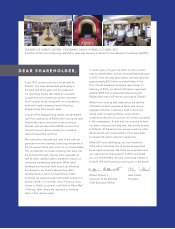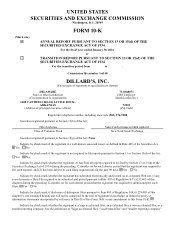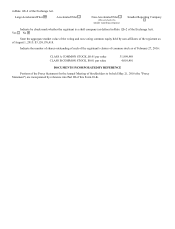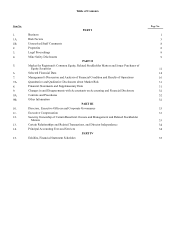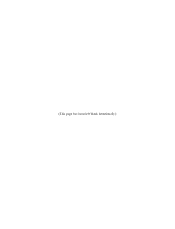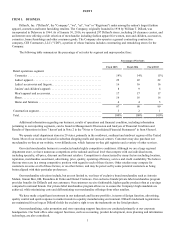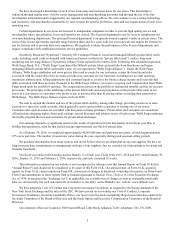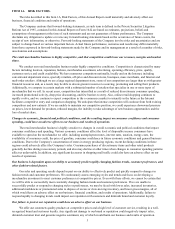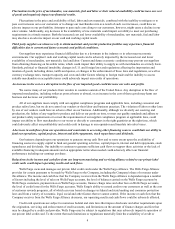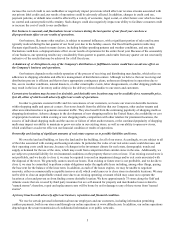Dillard's 2015 Annual Report Download - page 9
Download and view the complete annual report
Please find page 9 of the 2015 Dillard's annual report below. You can navigate through the pages in the report by either clicking on the pages listed below, or by using the keyword search tool below to find specific information within the annual report.3
ITEM 1A. RISK FACTORS.
The risks described in this Item 1A, Risk Factors, of this Annual Report could materially and adversely affect our
business, financial condition and results of operations.
The Company cautions that forward-looking statements, as such term is defined in the Private Securities Litigation
Reform Act of 1995, contained in this Annual Report on Form 10-K are based on estimates, projections, beliefs and
assumptions of management at the time of such statements and are not guarantees of future performance. The Company
disclaims any obligation to update or revise any forward-looking statements based on the occurrence of future events, the
receipt of new information, or otherwise. Forward-looking statements of the Company involve risks and uncertainties and are
subject to change based on various important factors. Actual future performance, outcomes and results may differ materially
from those expressed in forward-looking statements made by the Company and its management as a result of a number of risks,
uncertainties and assumptions.
The retail merchandise business is highly competitive, and that competition could lower our revenues, margins and market
share.
We conduct our retail merchandise business under highly competitive conditions. Competition is characterized by many
factors including location, reputation, fashion, merchandise assortment, advertising, operating efficiency, price, quality,
customer service and credit availability. We have numerous competitors nationally, locally and on the Internet, including
conventional department stores, specialty retailers, off-price and discount stores, boutiques, mass merchants, and Internet and
mail-order retailers. Although we are a large regional department store, some of our competitors are larger than us with greater
financial resources and, as a result, may be able to devote greater resources to sourcing, promoting and selling their products.
Additionally, we compete in certain markets with a substantial number of retailers that specialize in one or more types of
merchandise that we sell. In recent years, competition has intensified as a result of reduced discretionary consumer spending,
increased promotional activity, deep price discounting, and few barriers to entry. Also, online retail shopping continues to
rapidly evolve, and we continue to expect competition in the e-commerce market to intensify in the future as the Internet
facilitates competitive entry and comparison shopping. We anticipate that intense competition will continue from both existing
competitors and new entrants. If we are unable to maintain our competitive position, we could experience downward pressure
on prices, lower demand for products, reduced margins, the inability to take advantage of new business opportunities and the
loss of market share.
Changes in economic, financial and political conditions, and the resulting impact on consumer confidence and consumer
spending, could have an adverse effect on our business and results of operations.
The retail merchandise business is highly sensitive to changes in overall economic and political conditions that impact
consumer confidence and spending. Various economic conditions affect the level of disposable income consumers have
available to spend on the merchandise we offer, including unemployment rates, interest rates, taxation, energy costs, the
availability of consumer credit, the price of gasoline, consumer confidence in future economic conditions and general business
conditions. Due to the Company's concentration of stores in energy producing regions, recent declining conditions in these
regions could adversely affect the Company's sales. Consumer purchases of discretionary items and other retail products
generally decline during recessionary periods, and also may decline at other times when changes in consumer spending patterns
affect us unfavorably. In addition, any significant decreases in shopping mall traffic could also have an adverse effect on our
results of operations.
Our business is dependent upon our ability to accurately predict rapidly changing fashion trends, customer preferences, and
other fashion-related factors.
Our sales and operating results depend in part on our ability to effectively predict and quickly respond to changes in
fashion trends and customer preferences. We continuously assess emerging styles and trends and focus on developing a
merchandise assortment to meet customer preferences at competitive prices. Even with these efforts, we cannot be certain that
we will be able to successfully meet constantly changing fashion trends and customer preferences. If we are unable to
successfully predict or respond to changing styles or preferences, we may be faced with lower sales, increased inventories,
additional markdowns or promotional sales to dispose of excess or slow-moving inventory, and lower gross margins, all of
which would have an adverse effect on our business, financial condition, and results of operations. Additionally, failure to
respond rapidly to changing trends could impact our reputation with customers and diminish brand and customer loyalty.
Our failure to protect our reputation could have an adverse effect on our business.
We offer our customers quality products at competitive prices and a high level of customer service, resulting in a well-
recognized brand and customer loyalty. Any significant damage to our brand or reputation could negatively impact sales,
diminish customer trust and generate negative sentiment, any of which would harm our business and results of operation.


